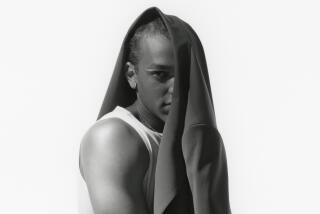The Finish Line
- Share via
As both a practicing attorney and the director of the L.A. Mart, Jay Grodin can more than afford a custom-made suit. He has the money--but not the patience to endure all the fittings. And buying something straight off the rack won’t do, either.
“I’m someone that focuses a lot on the details,” says Grodin, who has a standing appointment each season with the Chester Barrie suit rep at Carroll & Co. on Rodeo Drive. “For marginally extra dollars, they can do small things that really finish off the suit, like buttonholes at the cuff or adding an extra pocket.”
Grodin is a member of a growing group of executives who have discovered made-to-measure tailored clothing. It offers personalized garments but with fewer hassles and less expense than those made from scratch.
With major sportswear brands such as Levi Strauss and Haggar pushing the business-casual look, and button-down companies like IBM loosening their dress codes, sales of moderately priced suits have started to decline. The $400 to $800 range has suffered the worst, says Critt Rawlings, chief executive of Oxxford Clothing, which sells $1,600 to $2,000 suits to men who can’t relax on the job. But the high-end segment is doing well, up more than 20% in the past 24 months, spurred in part by made-to-measure garments, Rawlings says.
How does made-to-measure work? After calling ahead for an appointment, “A man picks from hundreds of fabrics in one of our books,” says Noah Alexander of Ermenegildo Zegna, a menswear label and store in Beverly Hills. “Then he gets measured and chooses a style from our selection of suit shapes for the season. In the process, he can change any of the details--working or nonworking buttonholes at the sleeve, side or center vents, pleats or no pleats, cuffed or non-cuffed slacks.”
At the factory, an existing pattern is altered to meet the customer’s specifications. Four to six weeks later, he has a suit that fits his budget and his sense of style.
“The difference in quality between custom and made-to-measure is maybe none,” says Martin Greenfield, a New York tailor for the past 47 years, who does both custom and made-to-measure clothing for dozens of designers and retailers, including Donna Karan, Alan Flusser, Brooks Brothers and Neiman Marcus.
“The process is the same. The only difference is how you get through the process. A custom suit has to be fit from scratch, whereas the made-to-measure garment is taken from a preexisting pattern and altered to fit the customer.”
There is a big difference in price, however. Most made-to-measure suits retail from $1,000 to $1,800, with 10% to 15% tacked on for the service. (Some stores waive their fees during promotions in January and August, the beginning of the spring and fall seasons, respectively.) With few exceptions, a custom suit is double or even triple that, depending on the shape, details and fabrics.
At some specialty stores, made-to-measure clothing now makes up as much as 25% of sales, compared to less than 2% in 1986. Many retailers like the idea offering more product without having to make room for it or to pay for it up front.
“There is no inventory. Essentially, you’re looking at a swatch of fabric,” says Stan Tucker, vice president and men’s fashion director for Saks Fifth Avenue, where made-to-measure fabric swatches are kept in a basket in the men’s suit departments.
But Kennon Earl, men’s suit buyer at Ron Ross in Studio City, is not so keen on the idea. The store no longer offers made-to-measure because many shoppers had difficulty picturing a fabric swatch as a suit, he says.
“Because the customer doesn’t see it before it’s made, he may not like the finished product and refuse to pay for it. So the store gets stuck with the merchandise.” In addition, clothing is often bought on impulse; most customers are too impatient to wait a month or more to take home their purchase.
Risky or not, upper-end clothing makers such as Hickey-Freeman, Oxxford, Valentino, Ermenegildo Zegna, Ralph Lauren and Chester Barrie of London’s Savile Row say that letting the customer personalize his suit has put some of the excitement back into buying tailored clothing.
“Clothes are very expensive and most men who spend $1,000 or more on a suit want it to last from five to seven years,” says John Carroll, owner of Carroll & Co. “If a guy is going to live with it that long, it better have all the details he loves. And the best way to ensure that is to create it yourself.”






